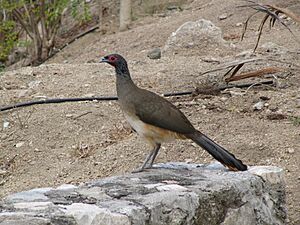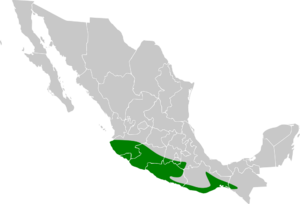West Mexican chachalaca facts for kids
The West Mexican chachalaca (Ortalis poliocephala) is a type of bird that lives only in Mexico. It belongs to the family of birds called Cracidae, which includes chachalacas, guans, and curassows.
Quick facts for kids West Mexican chachalaca |
|
|---|---|
 |
|
| In Mexico | |
| Conservation status | |
| Scientific classification | |
| Genus: |
Ortalis
|
| Species: |
poliocephala
|
 |
|
Contents
About its Name and Family
Scientists group animals together based on how they are related. The West Mexican chachalaca was first named Penelope poliocephala. Later, it was moved to the group Ortalis. For a time, some thought it was a type of plain chachalaca. But now, scientists agree it is its own unique species. This bird does not have any subspecies.
What it Looks Like
The West Mexican chachalaca is about 58.5 to 68.5 cm (1.9 to 2.2 ft) long. That's about the size of a large chicken! One male bird weighed about 760 g (1.7 lb). Its head and the back of its neck are a dull brownish-gray color. The rest of its upper body is a light brownish-olive. Its tail is a bit grayer, and the feathers have wide, light brown tips. The bird's chest is grayish-olive, and its belly is whitish with a light brown tint. It has hazel eyes that are surrounded by bare, red skin.
Where it Lives
This bird lives in a part of southwestern Mexico. You can find it from northern Jalisco down to southwestern Chiapas. It also lives inland as far as southwestern Puebla. It mostly lives in older forests where trees lose their leaves. It also likes thorny bushes and new forests that have grown back. Sometimes, you can find it in pine-oak forests. It can also live in mangrove swamps and palm tree farms. These birds live from sea level up to 2,400 m (7,900 ft) high in the mountains.
Behavior
What it Eats
The West Mexican chachalaca mostly looks for food on the ground. However, it will also climb into trees and bushes to find food. About two-thirds of its diet is fruit. The rest of its diet includes flowers, seeds, leaves, and insects.
Reproduction
The breeding season for the West Mexican chachalaca is from April to August. The busiest time for breeding is in June and July. Both the male and female birds build the nest. It is a shallow, flat nest made of sticks. It is lined with leaves and bromeliads. The nest is usually built up to 5 m (16 ft) above the ground. One nest was found to have three eggs. Only the female bird sits on the eggs to keep them warm. But both parents take care of the young birds after they hatch.
What it Sounds Like
The main sound the West Mexican chachalaca makes is a "gruff, throaty, rhythmic chattering." It sounds like "chur-uh-uh-uhr, etc."
Conservation Status
The IUCN (International Union for Conservation of Nature) has looked at the West Mexican chachalaca. They have decided that it is a species of "Least Concern." This means that there are enough of these birds, and they are not in danger of disappearing. It is quite common throughout the areas where it lives. People sometimes hunt these birds for food. However, it does not seem to be hunted so much that it causes a problem for the bird's population.


